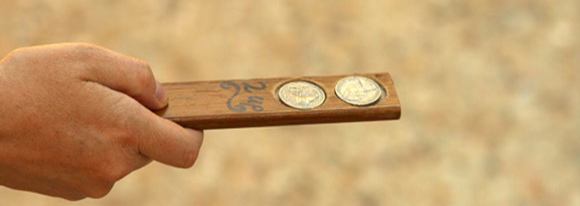The 25th of April was officially announced as Anzac Day in 1916 to mark the anniversary of the Gallipoli, the first military action fought by New Zealand and Australian forces during the First World War that led to major casualties.
Australians mark the occasion in many ways, including dawn services, “gunfire” breakfasts and sporting contests. One of the other ways many people choose to celebrate the spirit of the diggers is with a game of two-up. The game is often played in Returned Servicemen’s League (RSL) clubs, pubs, and hotels across Australia. But what exactly is two-up, and why is to so synonymous with Anzac Day?
History of Two-up
 The origins of two-up can be traced to pitch and toss, a gambling game that requires the spinning of a coin into the air and betting on the outcome. But as the name implies, two-up involved the spinning of two coins in the air and wagering on the result. By the 18th century, two-up was already popular among poorer Irish and English citizens. As early as the 1850s the game was been played in New South Wales goldfields, and it quickly spread across the country during the gold rushes.
The origins of two-up can be traced to pitch and toss, a gambling game that requires the spinning of a coin into the air and betting on the outcome. But as the name implies, two-up involved the spinning of two coins in the air and wagering on the result. By the 18th century, two-up was already popular among poorer Irish and English citizens. As early as the 1850s the game was been played in New South Wales goldfields, and it quickly spread across the country during the gold rushes.
During the First World War two-up was very popular among the Australian and New Zealand soldiers, including those who fought at Gallipoli. The game was played on the troop ships and in trenches while the war lasted. This is the main reason playing two-up has become part of the tradition of remembering the soldiers.
But before 1989, it was illegal to organise two-up games in Australia. In that year, however, the game was legalised for play on Anzac Day due with an amendment to the Australian gaming and betting laws.
The amendment was made in recognition of two-up’s significance as a national game and its widespread acceptance in the community as a game to be played on Anzac Day. Although, the game had been legalized under those circumstances, any profits made from running the games had to be donated to charity and not be reserved for personal interest. It was also illegal to charge an entrance fee at premises where the game is played on Anzac Day.
The game also has a strong tie with the Australian outback, mostly among rural workers like shearers and miners, particularly in the city of Broken Hill with its famous but illegal Crystal Lane two-up school, which was closed down in 1984 for operating illegally. In 1992, however, Broken Hill City Council successfully lobbied the state government to have laws amended to allow the game to be played on dates other than Anzac Day at the venue. The amendment was made based on the game being “an established part of the cultural heritage” of the mining city.
Further amendments were made in later years to permit the game to be played on other commemorative dates, such as Victory in the Pacific Day on 15th of August as well as on Remembrance Day on the 11th of November.
Nevertheless, the playing of the game on Victory and Remembrance Day are subject to the same conditions that are stipulated for playing the game on Anzac Day. But on Remembrance Day, the game may not be played until noon, to ensure that people observe the traditional solemnity of the morning services.
Why Is Two-Up A Traditional Part Of Anzac Day?
History was made on the 25th of April 1915, when Australian and New Zealand Army Corps (ANZAC) formed part of the allied forces that aim to capture the Gallipoli peninsula with a common objective to open the Dardanelles to the allied navies. Their aim was to take over Constantinople (now Istanbul in Turkey), which was the capital of the Ottoman Empire, and an ally of Germany.
Upon arrival at the Gallipoli peninsula, Anzacs met violent resistance from the Ottoman Turkish defenders. The battle, which commanders had originally hoped would end quickly, lasted for eight months. During that period, about 8000 Australian soldiers were killed. The news of their deaths had a strong impact on Australians at home. Towards the end of 1915, Anzacs were evacuated. But the day they first landed, 25th of April, is the day on which their commitment and bravery is collectively remembered.
During the eight month period when the Anzacs were on the Gallipoli peninsula, two-up was a favourite game among troops – hence its association with Anzac Day.
An aside: the Anzac biscuit
During the First World War, the families, friends and communities of soldiers at the battle field sent food to them. But due to the delays of delivering food to the men at the frontlines, they had to send non-perishable foods that would not require refrigeration during the long journey, while also retaining their nutritional value and remaining remain edible. Their solution was Anzac Biscuits.
 The biscuits were earlier called Soldier’s Biscuits. But the present name Anzac Biscuit is an outcome of the strong desire of Australians to remember the Anzac tradition as well as the biscuit as part of the common diet at the Gallipoli peninsula.
The biscuits were earlier called Soldier’s Biscuits. But the present name Anzac Biscuit is an outcome of the strong desire of Australians to remember the Anzac tradition as well as the biscuit as part of the common diet at the Gallipoli peninsula.
Although recipes for the biscuits vary slightly, most of the common ingredients are the same: bi-carbonate of soda, rolled oats, golden syrup or treacle, sugar, coconut, butter, as well as boiling water. The biscuit is one of the few items that can be marketed in Australia with the name Anzac and the name is protected by Federal Laws.
How To Play Two-up (rules of the game)
People play two-up game by forming a ring, usually on a flat surface such as floorboards. The game has a “ringkeeper”, who offers the “kip” (a wooden device for holding and tossing the coins) clockwise around the ring, giving the kip to the first person who decides to accept it. The ringkeeper may keeps two sets of seven pennies (or other coins – but pennies are traditional), throwing them down in the ring. The spinner selects one of the sets of pennies and puts them in the kip.
Only two pennies are used for the game, and only the ringkeeper can decide when the pennies should be changed. The tail sides of the coins are marked with a white cross and the spinner places the pennies tails up on the kip. The spinner then tosses the coins into the air. For a toss to be considered legitimate the spinner must toss the coins at least 10 feet in the air and the coins must land within the created circle without contact with any object. The spinner targets tossing two heads and bets against the crowd.
If the spinner successfully throws three double heads consecutively he or she can keep the proceeds or leave. But if the spinner ends up throwing tails, the spinner will lose the entire amount of money in the center and the right to toss. On Anzac Day, all proceeds are expected to be donated to charity.
Also, the other punters around the ring can place bets against each other on how the coins will land or on the chance two heads will land two times consecutively. The person wagering on tails has the responsibility of holding the money at stake. In most cases, the head side of the coins are well polished leaving the tail side a bit dark. This makes it easier for the crowd to identify which way the coins have landed.
